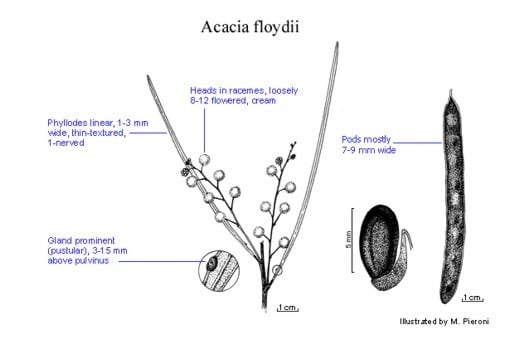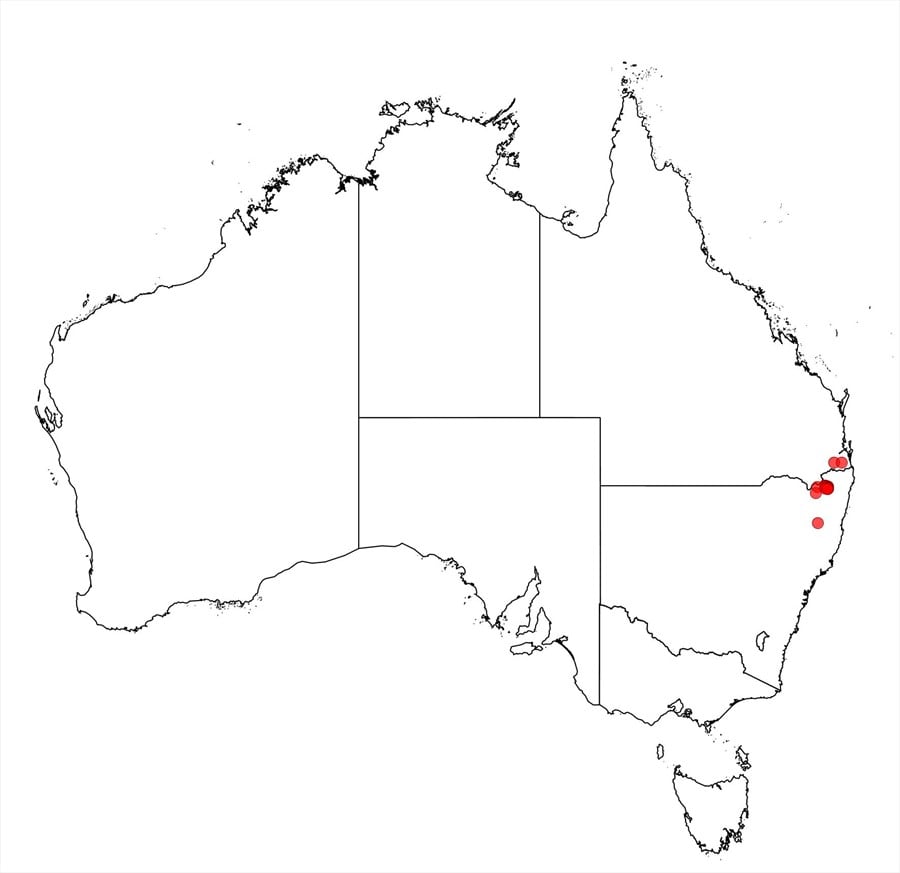Acacia floydii Tindale
WATTLE
Acacias of Australia
Family
Fabaceae
Distribution
Geographically restricted in the Great Divide, E of Tenterfield, north-eastern N.S.W. The Qld record of this species (as Racosperma floydii) by L.Pedley, Austrobaileya 2: 348 (1987), was based on a specimen now referred to A. acrionastes.
Description
Slender shrub or tree to c. 5 m high; juvenile bipinnate foliage often persistent. Branchlets flat or triquetrous at extremities, dark coloured, glabrous. Phyllodes narrowly linear, (6–) 7–13 cm long, 1–3 mm wide, slightly uncinate, thin, glabrous, 1-nerved; lateral nerves absent; gland pustulate, prominently exserted beyond margin, 3–15 mm above pulvinus. Inflorescences 8–11-headed racemes; raceme axes (2–) 3–7.5 cm long, slender, glabrous; heads globular, loosely 8–12-flowered, cream; peduncles 5–9 mm long, glabrous. Flowers 5‑merous; sepals 3/4‑united to almost to apex. Pods narrowly oblong, to 10 cm long, (6–) 7–9 mm wide, coriaceous to thinly coriaceous, dark brown to blackish, glabrous. Seeds longitudinal, oblong-elliptic, c. 6 mm long, slightly shiny, blackish; aril clavate.
Habitat
Grows near rainforest creeks or in moist sand on granite at 900–1100 m alt. in eucalypt forest.
Specimens
N.S.W.: Malara State Forest, A.G.Floyd 832 (NSW).
Notes
Closely related to A. acrionastes. Similar to narrow phyllode forms of A. fimbriata from Qld that were formerly called A. perangusta but which are distinguished by shorter phyllodes with smaller glands, smaller flowers on shorter peduncles and pruinose, apparently broader pods. Similar to A. adunca and A. betchei which have golden or bright pale yellow heads often with more flowers, and only slightly prominent or absent glands. Resembling A. macnuttiana in phyllode shape and size.
FOA Reference
Data derived from Flora of Australia Volumes 11A (2001), 11B (2001) and 12 (1998), products of ABRS, ©Commonwealth of Australia
Author
Minor edits by B.R.Maslin
B.R.Maslin
This identification key and fact sheets are available as a mobile application:
URL: https://apps.lucidcentral.org/wattle/
© Copyright 2018. All rights reserved.







